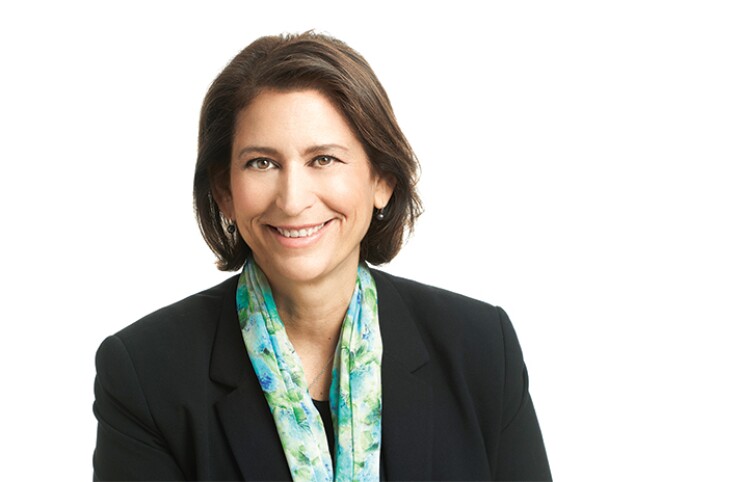Wells Fargo’s chief administrative officer and its chief auditor are both on leaves of absence — and have been removed from the company’s operating committee — in the latest fallout from the bank’s phony-accounts scandal.
Hope Hardison has been the San Francisco bank’s chief administrative officer since 2015. David Julian
For two years, both executives held onto their positions at the $1.9 trillion-asset bank even as various scandals led to the departures of numerous colleagues. That changed Wednesday, when Wells laid out a series of leadership changes that it is making as a result of the leaves of absence.
“These leaves relate to previously disclosed ongoing reviews by regulatory agencies in connection with historical retail banking sales practices,” the company stated in a press release. “These leaves of absence are unrelated to the company’s reported financial results or internal financial controls.”

Since the scandal surfaced in September 2016, Wells has disclosed that as many as 3.5 million accounts were opened without customers’ permission. The ensuing public outcry led to the abrupt departure of CEO John Stumpf, who was succeeded by Tim Sloan, and a series of actions designed to put the scandal to rest.
But over the last two years, Wells’ reputation has been further tarnished by a slew of additional scandals. The problems include abuses in the bank’s mortgage and auto lending operations, a wealth management probe and refunds for add-on products.
As recently as this summer, Wells Fargo was touting Hardison as the driving force behind some important changes that were made in the aftermath of the unauthorized account scandal, such as the bank’s decision to end product sales goals for branch employees. Last month, American Banker
But Hardison has also drawn scrutiny for her role in the unauthorized account scandal.
Back in March 2017, Wells announced that Hardison, Julian and six other top executives would not receive cash bonuses for the previous year in an effort to reinforce accountability for the scandal. The bank stressed that the reduced compensation was not the result of any findings of improper behavior.
The following month, a report by Wells Fargo’s board found that Hardison had been aware of problems involving sales practice since she became corporate human resources director in 2010. But it concluded that she did not understand the problems to be pervasive.
In February 2013, a Wells Fargo employee who reported to Hardison sent her a report that showed a total of more than 2,000 confirmed fraud or policy violations and related terminations and resignations in 2011 and 2012, according to the board’s report.
“Hardison did not recall reviewing this report in detail or having understood at that time the scope and nature of the sales integrity violations,” the report stated.
But the board’s report also portrayed Hardison as someone whose warnings about the growing scandal went unheeded by some of her colleagues.
For example, it stated that after Hardison became aware of approximately 1,000 additional employee terminations during 2013 for sales integrity violations, she was critical of the bank’s retail unit for its response.
As chief administrative officer, Hardison has also faced scrutiny regarding the company’s treatment of employees who blew the whistle on sales abuses. Some former employees
The board’s 2017 report stated that the law firm Shearman & Sterling had not found a pattern of retaliation against employees who complained about sales pressure. Hardison
Wells Fargo’s press release on Wednesday did not make clear what changed recently that prompted the personnel changes, and instead focused on what comes next.
“Because of the depth of our management team, we are confident in our ability to ensure an effective transition,” Sloan said in the press release.
As a result of the personnel actions, Kimberly Bordner, who is currently executive audit director, will become acting chief auditor, Wells Fargo said. David Galloreese will continue as head of human resources, report directly to CEO Tim Sloan and join the bank’s operating committee.
Three other members of the company’s operating committee — Chief Financial Officer John Shrewsberry, Chief Risk Officer Mandy Norton and Avid Modjtabai, who heads payments, virtual solutions and innovation — will take on responsibilities that previously fell to Hardison.
Regulators continue to keep a close eye on Wells Fargo, which remains under an order from the Federal Reserve that bars the bank from growing its assets until it makes improvements to its governance and controls.
On Monday, New York Attorney General Barbara Underwood announced a $65 million penalty on Wells for failing to disclose that its once heavily touted cross-selling ratio was built on employee misconduct.
“The misconduct at Wells Fargo was widespread across the bank and at every level of management — impacting both customers and investors who were misled,” Underwood said in a press release.





